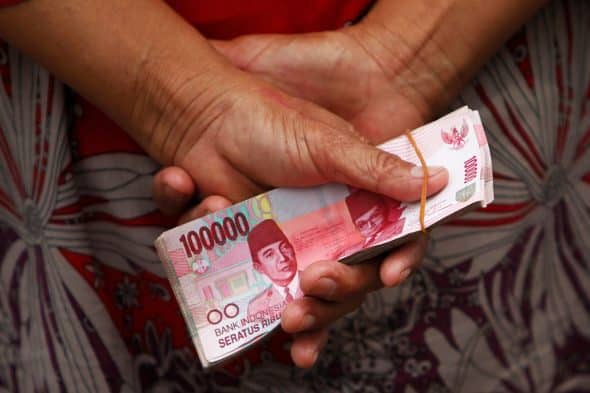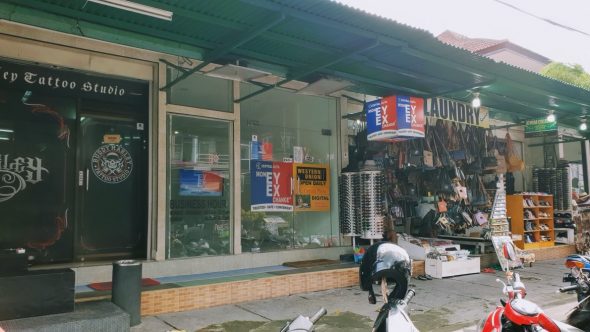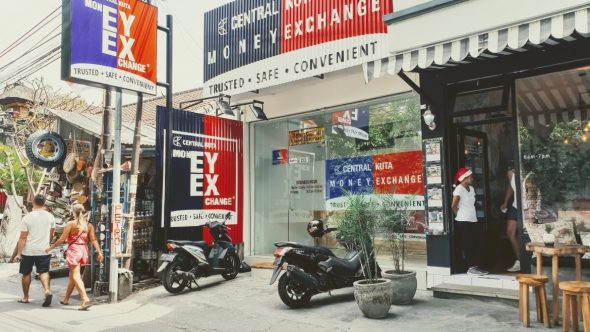Away from the major hotels and larger restaurants paying by credit card isn’t always possible, so you will need Rupiah while on holiday from money changers in Bali. Luckily money changers are plentiful and most — although definitely not all — are trustworthy and offer better exchange rates than you will get by withdrawing money from an ATM. Follow my guide and you’ll exchange currency for Indonesian Rupiah with confidence.
If you are here for a short time, say less than 4 or 5 days, using an ATM is fine. It’s easy, risk-free assuming you choose your ATM wisely and the amount you get charged by your bank is possibly worth the exorbitant fees they charge for the security and peace of mind they provide.
However, if you are planning on staying longer than a few days, and spending more than say USD$500, then using a money changer to exchange cash for Indonesian Rupiah (IDR), which is the local currency in Bali, makes good economic sense.
Changing your local currency into Indonesian Rupiah can be a painless and low-risk transaction if you follow these simple rules.
1. Pick somewhere popular.
We know this sounds obvious, but you would be surprised how many people go looking down back-alleys and side-streets thinking they are going to be able to get a better deal on the exchange rate and commission.
This is foolhardy at best and significantly increases the chances of being scammed. The larger and more established money exchanges are larger and established for a good reason.
Pick a money changer with direct frontage onto a main street with heavy walk-by traffic and ask the rate. Check it off the internet, and factor in their margin. If it’s close, you’re good to go.
Rule number one: use a popular money changer with direct frontage onto a main street with heavy walk-by traffic.
2. No commission. Just the market rate.
The best money exchanges don’t charge a commission. They have a regularly updated market rate that closely tracks the international inter-bank foreign exchange rate.
Places that charge a commission are simply going to make it up with a less competitive exchange rate, so you are not going to be any better off. All you are doing is making the transaction more complex than it needs to be, and therefore harder to tell at a glance if you are getting a reasonable deal or not.
Rule number two: use a money changer that doesn’t charge a commission with clearly published exchange rates.
3. The rate is the rate.
Unless you are looking to exchange more than USD$10,000 then trying to negotiate a better rate than advertised is most likely a waste of time.
The best exchanges will track a foreign exchange rate within 2-3 percentage points of the international inter-bank rate easily discoverable by checking the Internet — it really is that simple.
I recommend downloading the XE.com smart-phone app which you can get from Google Play for Android and App Store for iOS. Simply pick your currency and check the money changer’s rate — if it’s within 2-3 percentage points then you’re good to go. That’s the money changer’s markup and how they make a profit.
The rate published on xe.com is the inter-bank rate. So unless you are literally a bank, this is not the rate you are ever going to get.
For example, as of the time of writing (31 July 2018), xe.com was showing a mid-market rate of AUD$1 = IDR10,719 while Central Kuta Money Exchange was offering IDR10,550, which is as close a spread as you will ever get.
There will, however, be a slight difference between the smaller, name brand kiosks generally located outside supermarkets and shopping centres, which tend to be slightly more expensive than the larger, well-staffed and high volume money changers with larger shopfronts.
Rule number three: the Internet means foreign exchange rates are instantly transparent, so check the rate and if within 2-3 points you’re good.
A word of warning: if you are offered a rate better than the published rate on xe.com, then politely decline and leave the premises politely but firmly, because…
4. There is no such thing as free money.
It’s a very simple rule, but something about the prospect of free money appeals to peoples innate sense of greed. They start thinking they are the smartest person in the room (uh-oh).
If you are offered something too good to be true, you are literally a scam-in-progress.
This is dead easy to spot. As mentioned above, if you are offered an exchange rate better than that published on xe.com something is clearly wrong.
Politely decline and firmly leave the premises. Do not stay. The money changer in front of you will not magically transform from someone clearly trying to lure you into a scam into a wonderfully honest and trustworthy person to which you want to hand over your hard-earned cash.
Rule number 4: if the exchange rate offered is better than the one on xe.com, run.
5. What currency is best to bring to Bali?
The best money changers, BMC and Central Kuta Money Exchange, tend to have the best exchange rates and a plentiful supply of Indonesian Rupiah, so you can bring almost any currency and they will have a solid market rate. It really doesn’t matter which currency you bring as they will exchange most currencies without a problem.

The only time supply becomes an issue is if you are trying to exchange Indonesian Rupiah for foreign currency. Then you are best served by visiting an outlet and placing an order ahead of time. Both these outlets can arrange pretty much any currency you need, within reason, but obviously the more lead time the better. Inside a few hours is sometimes difficult but a day is usually enough.
6. Limit on bringing cash into Bali.
There is a new banking regulation brought in by the Indonesian Central Bank in March 2018 that only allows IDR 1 billion (approximately USD$75,000) in foreign currency notes to be brought in by individuals. If someone brings in more then customs officials have the power to confiscate it.
Be aware that any amount more than IDR 100 million (approximately USD$7,500) must be declared when clearing customs and you are required to report this on your immigration form that needs to be completed and presented on arrival.
7. Beware common scams.
While less common than they used to be, but unfortunately still common enough, are the smaller operations that will take any opportunity to scam an unsuspecting tourist.
Be careful when watching the count. A common scam is to count your exchanged IDR in front of you and just before handing it over palm a few notes using sleight of hand. Once you hold the wad of cash in your hand, the transaction is excepted and any short-changing is difficult to come back from.
You can rant and yell all you like, but it is virtually impossible to prove you have been scammed.
Don’t forget it works the other way around. There are plenty of tourists who make a fuss when they get their money and rant about being short-changed when they weren’t. This never ends well.
That’s why the best money changers fill out a form noting the amount of foreign currency you are changing, the exchange rate and the amount of IDR you will receive.
If you are a bit nervous, simply make sure you have the form completed to your satisfaction before handing over your currency.
Check the paperwork has the amount you are tendering, the exchange rate is correct and the amount in IDR you will receive.
Follow these simple rules and your chances of being scammed are practically none.
Rule number 5: avoid small operations that play fast and loose with the paperwork.
8. Locations of the Best Money Changers in Bali.
The Money Changers we recommend as easily accessible, trustworthy, commission-free with consistently competitive rates are BMC and Central Kuta Money Exchange.
Central Kuta Money Exchange, Seminyak

Address: Jalan Camplung Tanduk No.100-103, Seminyak
Open Hours: Mon-Sun 8:10am-9:15pm
Central Kuta Money Exchange, Seminyak

Address: Jalan Kayu Jati, Seminyak
Open Hours: Mon-Sun 08:15am-03:00am
Keeping your money safe is easier when you know how. I suggest you read my posts on Bali Currency and how to safely use ATMs in Bali. Have a great holiday!



